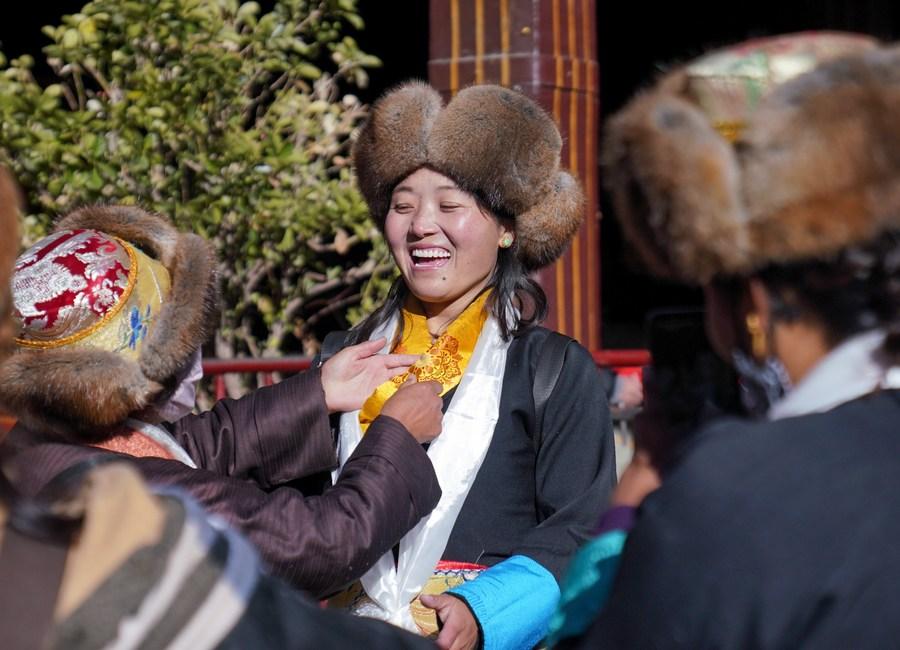Column: Tibet secures remarkable achievements in empowering women

Women of the Tibetan ethnic group celebrate the Fairy's Day at the Jokhang Temple in Lhasa, capital of southwest China's Tibet Autonomous Region, Dec. 10, 2019. (Xinhua/Jigme Dorje)
BEIJING, July 11 (Xinhua) -- Prior to the peaceful liberation of Tibet in 1951, women in the region were deprived of fundamental human rights, lacking any substantial guarantees or protections of their rights.
In old Tibet, women were subjected to a deeply entrenched system of oppression. They occupied the lowest rung of society, facing subjugation from divine, governmental, and patriarchal powers. As a result, they were deprived of power, status, and meaningful participation in social affairs.
In the public sphere, explicit provisions in old Tibet prohibited women from engaging in social and political activities.
Even within the confines of their families, women in Tibet found themselves in subordinate roles, devoid of economic autonomy and lacking access to education.
Following the launch of the epochal democratic reform in Tibet in 1959, which abolished the serfdom system, particularly after the establishment of the Tibet Autonomous Region, there has been significant progress in establishing the rule of law. This progress has led to the development of human and women's rights, which are now protected and governed by laws.
A comprehensive framework of laws and local regulations has created a conducive environment for women in this region, offering increased opportunities and favorable conditions for their development. Of particular significance, the measures for implementing the Law on the Protection of Rights and Interests of Women in Tibet, together with other relevant local legislation, act as crucial guards to ensure the right to development for women in Tibet in diverse areas, including politics, economy, culture, society, and family.
The people's government of the Tibet Autonomous Region has enacted a series of normative documents that serve as crucial legal and policy safeguards for the development of women in the region. These documents cover various aspects such as gender equality assessment, healthcare, personal safety, labor and employment, and maternity protection.
Plans have been designed to ensure women's rights to development through various strategic measures. These include expanding the availability of public services, implementing poverty eradication initiatives, enhancing the quality of education, fostering educational equity, promoting employment opportunities and entrepreneurship, reducing income inequality, and establishing a more equitable and sustainable social security system.
According to regional official statistics, by the end of 2022, women civil servants constituted 32.96 percent of the total civil servant workforce in the region. In terms of education, the situation of women in old Tibet was dire, with over 95 percent of them illiterate. In 2020, the proportion of female students in primary and junior high schools in Tibet stood at approximately 49 percent of the total number of students in these schools, and the number of female students in higher education, postgraduate education, and adult higher education remained above 50 percent of the total number.
By 2021, the average life expectancy in Tibet reached 72.19 years, compared to 35.5 years recorded in 1951. Efforts in the development and protection of women's groups have yielded positive outcomes as well. For instance, the Women's Federation of Tibet Autonomous Region implemented an initiative for women's poverty alleviation. Through dedicated efforts, this federation secured training funds that amounted to over 21 million yuan (around 2.9 million U.S. dollars) and conducted skills training programs. As a result, approximately 27,000 impoverished women received employment support, contributing to their economic empowerment.
The government has implemented proactive measures to ensure that women in Tibet have equal access to resources and opportunities. This includes the incorporation of provisions specifically addressing women's rights to development. Furthermore, targeted initiatives have been implemented, addressing issues of inequality in the right to development.
Collaborative endeavors in governance have been instrumental in elevating the overall level of social security, thereby strengthening the right to development for women in Tibet. Notable improvements have been made in the social security system, encompassing crucial aspects such as maternity protection, pension, unemployment insurance, and other forms of social welfare.
These advancements have provided women in Tibet with enhanced rights and opportunities, and their equal access to economic resources, employment opportunities, and entrepreneurial support was thus ensured. Enditem
(Editor's note: Penba Lhamo is a researcher at the National Institute of International Strategy, Chinese Academy of Social Sciences. The views expressed in this article are those of the author and do not reflect the positions of Xinhua News Agency.)
